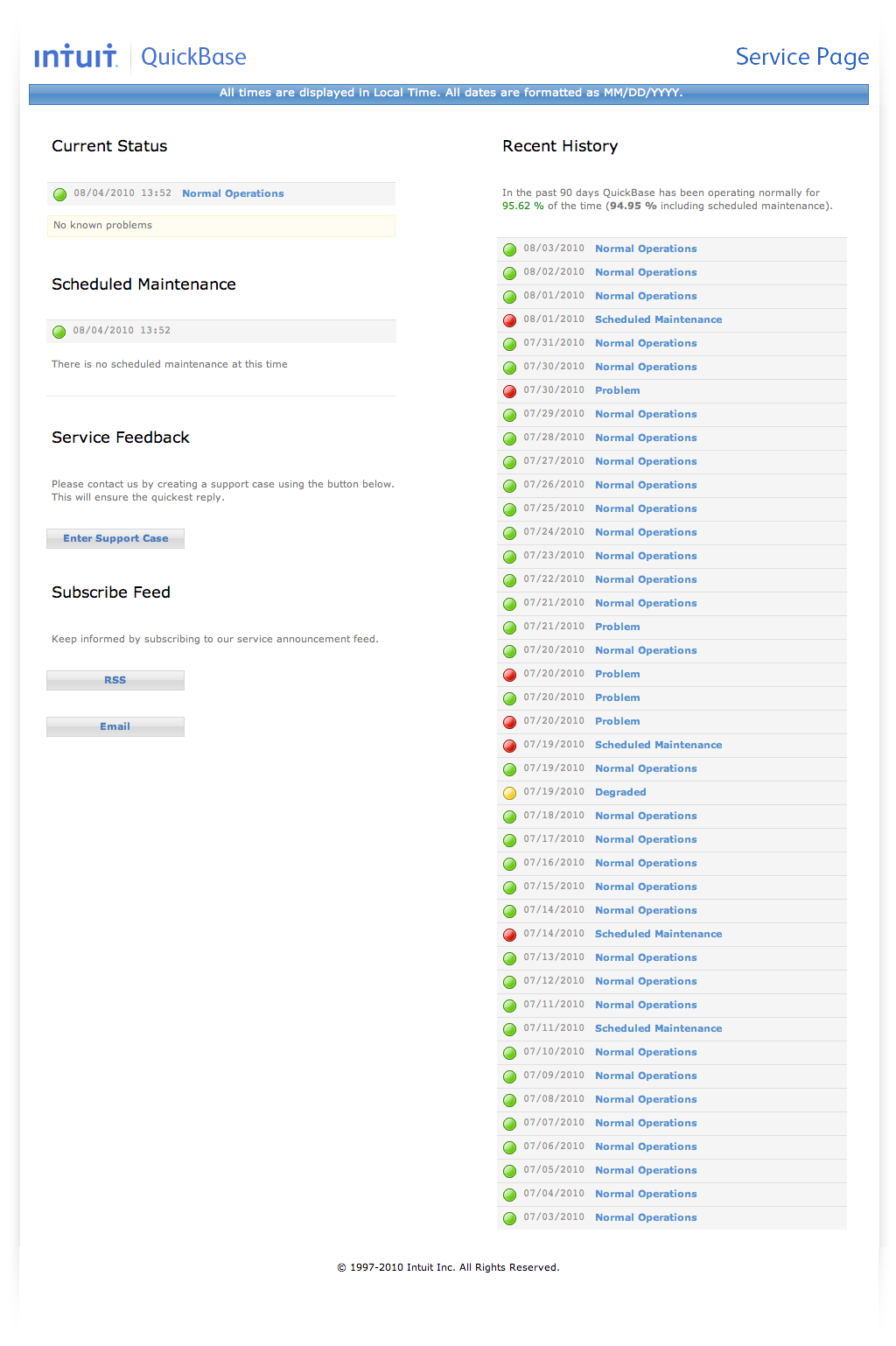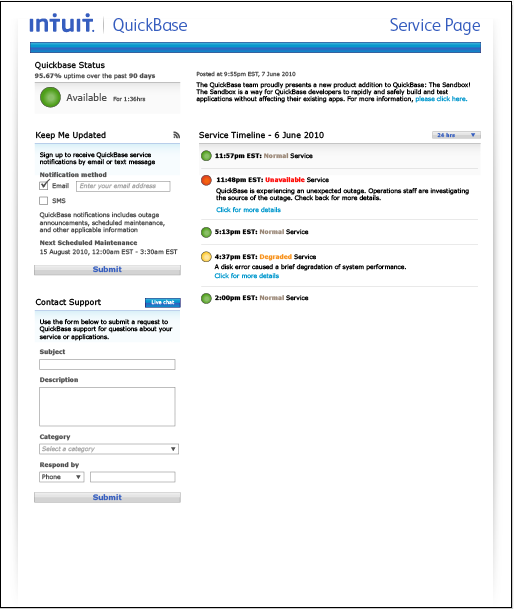QuickBase Service Page
Crisis management for a critical web service
Crisis management for a critical web service

The redesigned Service Page, showing the current status of the service, recent history with a detail view of problem statuses, and notifications of upcoming maintenance events. Additional support options are aligned on the right.
In mid-2010, Intuit's QuickBase product - an online database used to create applications that support all manner of businesses, municipalities, and other institutions - experienced an unprecedented series of outages, leaving customers without access for hours or days at a time. This unusual event caused a great deal of angst within a business unit that prided itself on delivering 99.8% uptime, guaranteed.
Exacerbating the problem was the fact that the Service Page for QuickBase, theoretically the place where users could go for updates and information during unexpected downtime, had substantial usability and functionality problems, and moreover was updated via a primarily manual process that often fell by the wayside during times of crisis. Since QuickBase customers used the service to run everything from small business to airport maintenance shifts, it became critical to redesign the Service Page to be more usable and informative, and so they brought their problem to the Design Innovation Group, a sort of internal design consultancy at Intuit, of which I was a part.
We focused our redesign approach around two key functions: information: providing inbound users with up-to-date information about the service status, and taking action: providing users with several input / communication mechanisms to allow them to "take control" of their individual situation during a unexpected downtime by taking explicit actions, reassuring them that their concerns were heard.
Serving the information function is a large, unambiguous indicator of current service status in the upper left, along with an expanded list view of recent service status updates, including the ability to drill into problem statues for more details. A notification sign-up form and support case form directly on the page served the function of taking action - previously, the Service Page contact form linked to a separate page hosted on QuickBase itself, meaning that during outages, the form was unavailable to users!
During the redesign, I worked with an engineer and a researcher as part of the team, creating wireframes, screen mockups, and generally leading all design activities. In collaboration with our researcher, I performed lightweight user testing of prototypes to refine our design, and worked with our engineer to provide design assets for implementation.
Exacerbating the problem was the fact that the Service Page for QuickBase, theoretically the place where users could go for updates and information during unexpected downtime, had substantial usability and functionality problems, and moreover was updated via a primarily manual process that often fell by the wayside during times of crisis. Since QuickBase customers used the service to run everything from small business to airport maintenance shifts, it became critical to redesign the Service Page to be more usable and informative, and so they brought their problem to the Design Innovation Group, a sort of internal design consultancy at Intuit, of which I was a part.
We focused our redesign approach around two key functions: information: providing inbound users with up-to-date information about the service status, and taking action: providing users with several input / communication mechanisms to allow them to "take control" of their individual situation during a unexpected downtime by taking explicit actions, reassuring them that their concerns were heard.
Serving the information function is a large, unambiguous indicator of current service status in the upper left, along with an expanded list view of recent service status updates, including the ability to drill into problem statues for more details. A notification sign-up form and support case form directly on the page served the function of taking action - previously, the Service Page contact form linked to a separate page hosted on QuickBase itself, meaning that during outages, the form was unavailable to users!
During the redesign, I worked with an engineer and a researcher as part of the team, creating wireframes, screen mockups, and generally leading all design activities. In collaboration with our researcher, I performed lightweight user testing of prototypes to refine our design, and worked with our engineer to provide design assets for implementation.
Process Work

This is the original Service Page before the redesign. In this version, the service status is listed on the right, with no indication of what caused problems, how long they last, or how they were resolved. The email and RSS notification functionalities were limited in scope and partially broken, and the feedback for was actually hosted within Quickbase, meaning that if the service went down, customers would be unable to enter their service requests and reports.

A directional concept focused on strong alerts for the user during outages.

A directional concept aiming to balance communication options with status updates.

A directional concept focused very strongly on providing notification and communication options for the user.

Early block-and-line wireframe based on pencil sketches. The inclusion of QuickBase team members at the bottom was meant to reassure users that real, caring humans were working on their service issues, removing the impression that they were dealing with an uncaring large corporation.

Preliminary pencil sketch for a balanced notification / action concept.




